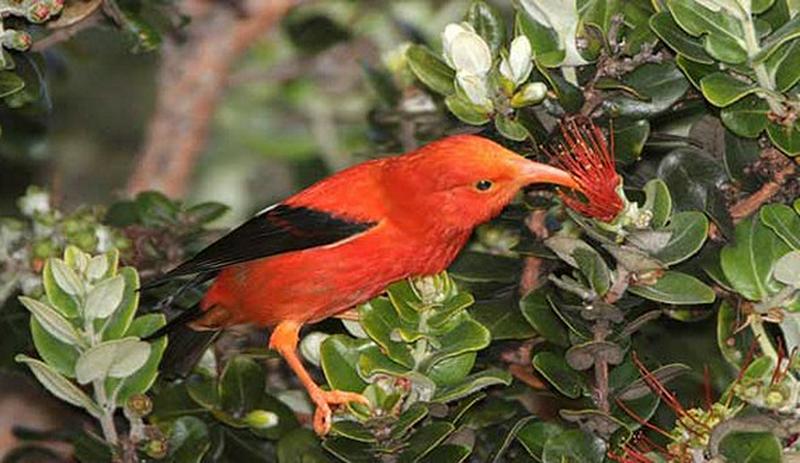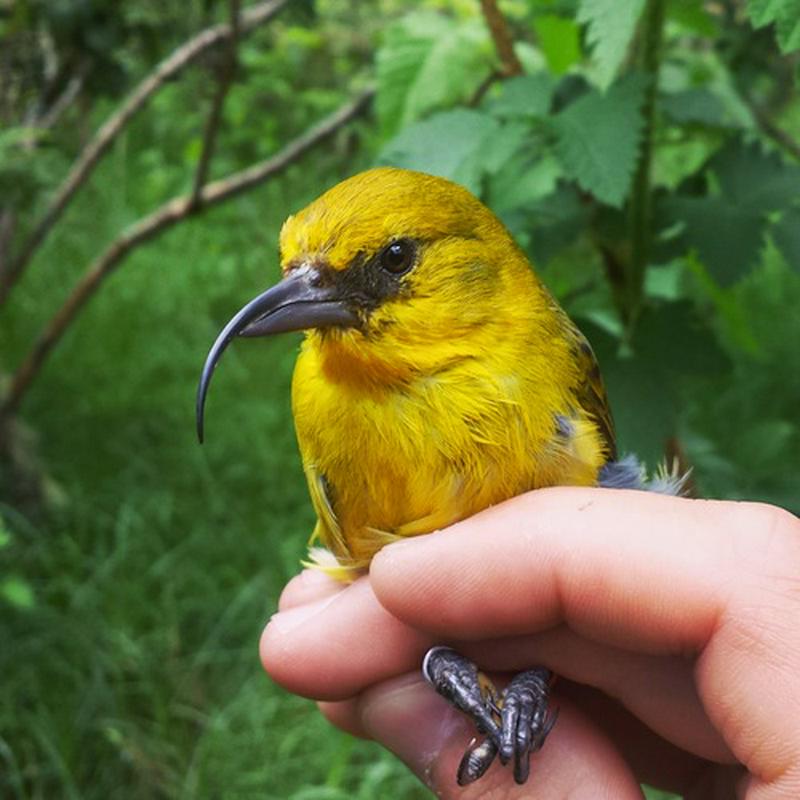Saying Goodbye: Species We Lost to Extinction in 2023
By Sophia Maddox | April 1, 2024
Molokai creeper (Hawaii)
In 2023, our planet bore witness to the sobering reality of extinction as several precious species vanished from the face of the Earth. From the lush forests of Hawaii to the winding rivers of Ohio, these once-vibrant inhabitants of our diverse ecosystems met their untimely demise. 'Saying Goodbye: Species We Lost to Extinction in 2023,' serves as a somber tribute to the unique creatures that once enriched our world. Join us in paying homage to their existence, illuminating the factors that drove them to extinction, and advocating for the pressing importance of conservation in safeguarding our planet's delicate biodiversity. Together, we will reminisce and contemplate the lives and ecosystems forever transformed by the departure of these extraordinary species.

The Molokai Creeper, a once-vibrant Hawaiian bird, sadly met extinction in 2023. Endemic to the island of Molokai, this bird was characterized by its striking crimson plumage and unique foraging habits. The Molokai Creeper's decline was primarily driven by habitat destruction and the introduction of invasive species. Its extinction serves as a somber reminder of the urgent need for conservation efforts to protect Hawaii's native avian species and the delicate ecosystems they depend on.
Little Mariana fruit bat (Guam)

The Little Mariana fruit bat, scientifically known as Pteropus tokudae, was a remarkable species endemic to the island of Guam. These small bats had a wingspan of about 24 inches (60 cm) and played a crucial ecological role as pollinators and seed dispersers in their native habitat. Unfortunately, in 2023, this unique species met its tragic end, primarily due to habitat destruction caused by human development and the introduction of invasive species, such as the brown tree snake. The extinction of the Little Mariana fruit bat serves as a poignant example of how human activities can have devastating consequences on fragile island ecosystems and underscores the urgent need for conservation efforts to protect our planet's biodiversity.
Po'ouli (Hawaii)

The Po'ouli, a critically endangered Hawaiian bird, tragically went extinct in 2023. Known for its distinctive appearance with a long, downward-curved bill and striking plumage, the Po'ouli was endemic to the island of Maui. Despite dedicated conservation efforts, its small population dwindled due to habitat loss, disease, and the introduction of invasive species. The Po'ouli's extinction serves as a stark reminder of the fragility of island ecosystems and the urgent need for habitat preservation and invasive species control to protect the unique avian diversity of Hawaii.
Maui nukupuʻu (Hawaii)

The Maui Nukupu'u, a striking Hawaiian bird with its distinctive curved bill and vibrant colors, sadly became extinct in 2023. This species, known for its unique foraging behavior of stripping bark from trees in search of insects, was exclusive to the island of Maui. The loss of the Maui Nukupu'u highlights the urgent need for comprehensive conservation measures to protect Hawaii's endangered avian species and their fragile habitats.
Java Stingaree (Indonesia)

The Java Stingaree, a mesmerizing marine creature found off the coast of Indonesia, is a species that regretfully disappeared in 2023, it is the first marine fish confirmed to have gone extinct due to human actions. With its flattened body and striking pattern of dark spots, it was an elusive and captivating sight for divers and marine enthusiasts. This stingaree was not only a testament to the rich marine diversity of the region but also a reminder of the ongoing challenges facing our oceans. Habitat degradation, overfishing, and climate change all contributed to the decline of this species. Its extinction underscores the urgency of marine conservation efforts in preserving the unique and fragile ecosystems of Indonesia's waters.
Maui 'ākepa (Hawaii)

The Maui 'ākepa, a beautiful Hawaiian bird, faced a tragic fate as it went extinct in 2023. This unique and colorful species, characterized by its vibrant yellow plumage and distinctive bill, was native to Maui. Habitat loss and the relentless threat of introduced diseases and invasive species were the key factors that contributed to its decline. The loss of the Maui 'ākepa underscores the importance of conserving and restoring Hawaii's fragile ecosystems to protect its remaining endemic bird species from a similar fate.
The Maui 'ākepa unique and melodious song, once a part of Maui's natural symphony, can be listened to here.
Bridled white-eye (Guam)

The Bridled White-eye, a charming and distinctive bird native to Guam, became extinct in 2023. This small bird, with its characteristic white eye-ring and vibrant plumage, was an essential pollinator for the island's flora. Sadly, the introduction of invasive species and habitat degradation led to its decline. The extinction of the Bridled White-eye highlights the importance of protecting the unique biodiversity of Guam and the critical role these small but significant birds played in maintaining the island's ecological balance.
Bachman’s warbler (once found in Florida, South Carolina)

Bachman's Warbler, a once-elusive bird species found in Florida and South Carolina, sadly disappeared from the wild in 2023. This small, colorful warbler with its striking plumage was known for its secretive nature and elusive behavior, making it a challenge for birdwatchers and researchers to study. Habitat loss, particularly the destruction of its breeding grounds in bottomland hardwood forests, was a significant factor contributing to its extinction.
"Each of these species represents a permanent loss to our nation's natural heritage and to global biodiversity," Bridget Fahey, who oversees species classification for the Fish and Wildlife Service, told The New York Times. "And it's a sobering reminder that extinction is a consequence of human-caused environmental change."
Kauai Akialoa (Hawaii)

The Kauai Akialoa, a fascinating Hawaiian bird, sadly went extinct in 2023. Endemic to the island of Kauai, it was a distinctive member of Hawaii's avian fauna. This unique bird featured a long, curved bill specifically adapted for extracting nectar from the native Hawaiian flora. Its specialized feeding habits and adaptation to its island habitat made it a remarkable example of Hawaii's rich avian diversity. Tragically, the Kauai Akialoa fell victim to habitat loss and invasive species, marking the loss of yet another emblematic Hawaiian species. Its extinction serves as a stark reminder of the fragility of island ecosystems and underscores the pressing need for conservation efforts to safeguard Hawaii's unique and endangered wildlife.
Kauaʻi ʻōʻō (Hawaii)

The Kaua'i ʻōʻō, a magnificent Hawaiian bird, sadly met extinction in 2023. This avian gem was exclusive to the island of Kaua'i and was distinguished by its striking black plumage, complemented by vibrant yellow leg feathers. What made the Kaua'i ʻōʻō even more special was its enchanting song, a melodious and haunting melody that once filled the lush forests of the island.
This bird's decline was primarily driven by habitat loss due to deforestation and the introduction of invasive species like rats and mosquitoes, which transmitted avian diseases. The Kaua'i ʻōʻō's extinction is not just a loss for Hawaii's avian diversity, but also a poignant reminder of the interconnectedness between species and the fragility of island ecosystems.
Numerous Mussels Went Extinct in 2023

In 2023, the world witnessed the heartbreaking extinction of several mussel species, each leaving a void in their respective aquatic ecosystems. Among those lost were:
1. Flat Pigtoe (Alabama, Mississippi): This freshwater mussel, distinguished by its flat, oval shape, once flourished in the waterways of Alabama and Mississippi. Regrettably, habitat destruction and pollution contributed to its ultimate extinction.
2. Southern Acornshell (Alabama, Georgia, Tennessee): Native to Alabama, Georgia, and Tennessee, the Southern Acornshell mussel bore a distinctive acorn-like shape. Tragically, pollution and habitat degradation played a pivotal role in its decline.
3. Stirrupshell (Alabama, Mississippi): Inhabitants of the waters in Alabama and Mississippi, the Stirrupshell mussels were characterized by their stirrup-shaped appearance. These remarkable creatures were unable to withstand the pressures of habitat loss and water quality deterioration.
4. Upland Combshell (Alabama, Georgia, Tennessee): The Upland Combshell mussel, with its comb-like ridges, was once a denizen of Alabama, Georgia, and Tennessee. Sadly, it succumbed to the impacts of habitat destruction and pollution.
5. Green-Blossom Pearly Mussel (Tennessee, Virginia): Native to Tennessee and Virginia, the Green-Blossom Pearly Mussel displayed a distinctive greenish hue. It's tragic extinction underscores the pressing need for enhanced water conservation efforts.
6. Tubercled-Blossom Pearly Mussel (Alabama, Illinois, Kentucky, Tennessee, Michigan, Ohio, West Virginia): This mussel species, recognizable by its tubercled shells, was spread across several states. Its extinction highlights the challenges faced by freshwater mussels in a wide geographical range.
7. Turgid-Blossom Pearly Mussel (Alabama, Arkansas, Tennessee): Inhabitants of Alabama, Arkansas, and Tennessee, the Turgid-Blossom Pearly Mussel struggled against habitat alteration and water pollution, leading to their unfortunate extinction.
8. Yellow-Blossom Pearly Mussel (Alabama, Tennessee): Native to Alabama and Tennessee, the Yellow-Blossom Pearly Mussel displayed striking yellow markings on its shells. Sadly, it fell victim to habitat degradation and pollution in its native waters.
These extinctions serve as poignant reminders of the critical importance of preserving freshwater ecosystems and the urgent need for comprehensive conservation measures to protect the remaining vulnerable species in our rivers and streams.
San Marcos gambusia (Texas)

The San Marcos Gambusia, a unique and locally-adapted fish species found exclusively in Texas, met its unfortunate demise in 2023. This tiny, unassuming fish, known for its ecological role in controlling mosquito populations, was a crucial part of the San Marcos River ecosystem. Its extinction highlights the challenges faced by many freshwater species due to habitat destruction, pollution, and invasive species. The loss of the San Marcos Gambusia serves as a stark reminder of the importance of preserving and conserving local ecosystems and their endemic inhabitants. Sadly, the gentle ripples of the San Marcos River no longer host this species that once played a vital role in its waters.
Scioto madtom (Ohio)

The Scioto Madtom, an exclusive and unique fish species found solely in one small section of Big Darby Creek, Ohio, tragically vanished in 2023. This inconspicuous yet vital creature, native to Ohio's waters, was known for its distinctive appearance and behavior. It fell victim to habitat degradation and water pollution, prompting speculation that it may have served as an environmental indicator, succumbing to the detrimental effects of industrial and agricultural runoff and other forms of pollution. The announcement of its extinction underscores the pressing need for comprehensive conservation measures to safeguard Ohio's delicate aquatic ecosystems and the myriad species that depend on them. Sadly, the quiet currents of Big Darby Creek and its connection to the Scioto River no longer host this remarkable species that once played a pivotal role in its unique environment.

